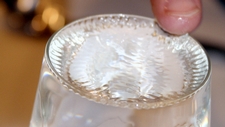Sound Energy

TEKS Objective
The student will investigate the effects on an object by increasing or decreasing amounts of light, heat, and sound energy such as how the color of an object appears different in dimmer light or how heat melts butter.
Essential Understanding
The student knows that forces cause change and energy exists in many forms.
Science Background
What is Sound? National Oceanic and Atmospheric Administration (website) - Information about the basics of sound, including decibel scale, along with more in-depth concepts related to sound.
What is Sound?
National Oceanic and Atmospheric Administration, www.pmel.noaa.gov
Discovery of Sound in the Sea: Office of Marine Programs (website) - Learn how sound travels in the oceans.
What are Common Underwater Sounds?
Discovery of Sound in the Sea, www.dosits.org
Signature Lesson
The Phenomenon of Sound, Waves: Discovery Education (website) - While rotating through six “sound centers,” students learn that sound is a form of energy that is caused by forces, travels in waves, and can pass through all forms of matter.
The Phenomenon of Sound, Waves
Discovery Education, www.discoveryeducation.com
The Phenomenon of Sound, Waves: Discovery Education (website) - While THEY rotate through six “sound centers,” students learn that sound is a form of energy that travels in waves and can pass through all forms of matter.
The Phenomenon of Sound, Waves
Discovery Education, www.discoveryeducation.com
Exploring Sound: K8Science (PDF) - Students rotate through stations for each activity below and record what they learn about sound at each station in their science notebooks.
- Supporting Lessons
- Extensions
- Assessment Ideas
- Literature Connections
- Related
TEKS - Additional Resources
Supporting Lessons
Physics at Your Desk… Drumming Fingers: American Physical Society (website) - Investigate the transport of sound waves through a variety of materials.
Physics at Your Desk… Drumming Fingers
American Physical Society, www.physicscentral.com
Sound: SEDL (PDF) - A curricular unit on sound; each lesson investigates a different property of sound. Includes teacher background and assessment.
Sound is Vibration: SEDL (website) - Students investigate the sounds produced by different containers of water.
Elaboration Lessons and Extensions
Hilarious Honker: TryScience (website) - Students discover how a plastic or paper cup affects sound vibrations.
Hilarious Honker
TryScience, www.tryscience.org
Exploring with Sound: TryScience (website) - Students use sound to determine the position of the objects making the sound.
Exploring with Sound:
TryScience, www.tryscience.org
Musical Coat Hangers: TryScience (website) - Students discover how sound travels and which materials provide the best sound conductivity.
Musical Coat Hangers
TryScience, www.tryscience.org
CANdemonium: Exploratorium (website) - Students fashion a musical instrument from recycled cans.
CANdemonium
Exploratorium, www.exploratorium.edu
Secret Bells: Exploratorium (website) - Students build a tool that increases the amount of sound reaching their ears.
Secret Bells
Exploratorium, www.exploratorium.edu
Ear Guitar: Exploratorium (website) - Students construct an “ear guitar” with cups and string, and hear the sound produced by string vibrations.
Assessment Ideas
Provide students with metal nails of several different lengths. Have students arrange the nails in order, from highest pitch to lowest pitch, based on the sound they produce when struck with a pencil.
Literature Connections
Sound: Reading Essentials in Science. Karpelenia, J. (ISBN-13: 978-0756944520)
Adventures in Sound with Max Axiom, Super Scientist. Sohn, Emily (ISBN-13: 978-0736868365)
Sound. Stille, Darlene (ISBN-13: 978-0756509781)
Additional Resources
What is Energy? K-12 Energy Education Program (website) - Simple activities and experiments that teach different forms of energy.
What is Energy?
K-12 Energy Education Program, www.uwsp.edu
Sound Is Energy: Oracle ThinkQuest (website) - Interactive website devoted to sound energy, including the difference between noise and music. Includes graphics that illustrate pitch and volume and projects through which students can explore the properties of sound.
TEKS Navigation
Grade 2
Need Assistance?
If you need help or have a question please use the links below to help resolve your problem.

Comments